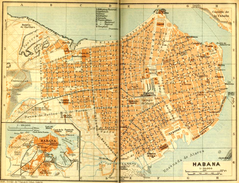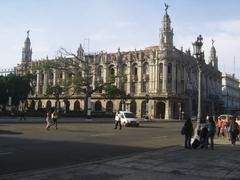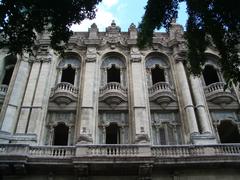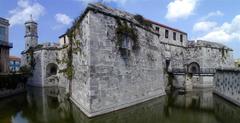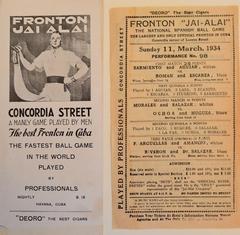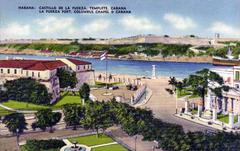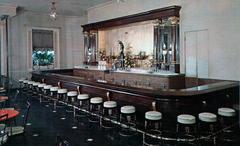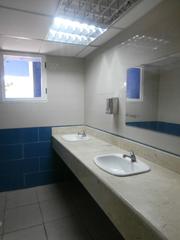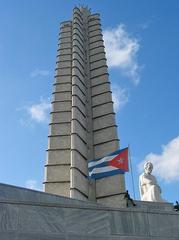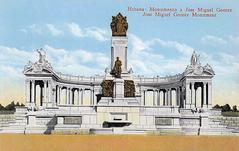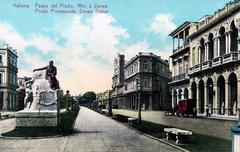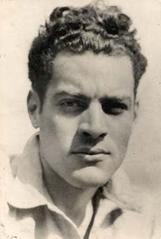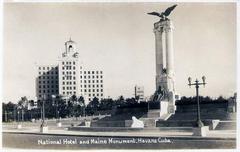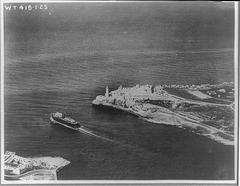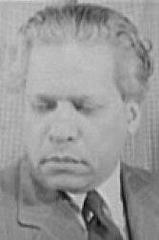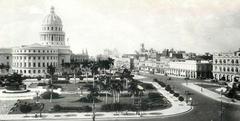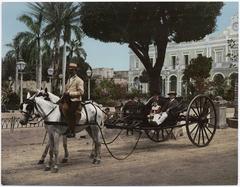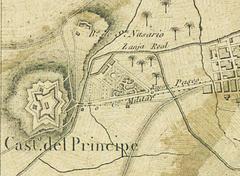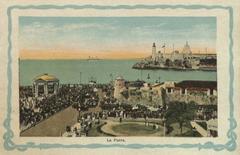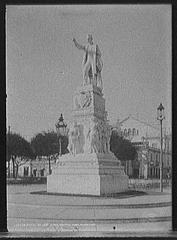
Gran Teatro De La Habana Visiting Guide and Tickets Information
Date: 14/06/2025
Introduction to Gran Teatro De La Habana
Situated in the heart of Havana, the Gran Teatro de La Habana is a symbol of Cuban cultural heritage and architectural brilliance. Originally built on the foundations of the 19th-century Teatro Tacón, this iconic venue has witnessed Havana’s transformation into a global cultural capital. Today, it serves as a prestigious home for the National Ballet of Cuba and the renowned International Ballet Festival of Havana. The theater’s neo-baroque façade, adorned with allegorical sculptures, and its grand marble interiors offer an immersive experience for those eager to explore Cuba’s rich artistic traditions.
This guide provides detailed information on the theater’s history, architectural highlights, practical visitor information—including visiting hours, tickets, and accessibility—and tips for making the most of your visit. For further insights, refer to resources such as LaHabana.com, Factsgem, and Wikipedia.
Historical Foundations and Architectural Evolution
From Teatro Tacón to Gran Teatro de La Habana
The Gran Teatro de La Habana’s story begins in the early 19th century with the opening of Teatro Tacón in 1838. Recognized as Havana’s most significant theater at the time, it quickly became a hub for the city’s elite and a platform for international artists. Its location, opposite Parque Central and near the Paseo del Prado, made it a key venue in Havana’s social and cultural life (LaHabana.com, Wikipedia).
By the early 20th century, the site underwent a major transformation with the construction of the Centro Gallego, designed to serve as a social and cultural center for the Galician community. The American engineering firm Purdy & Henderson and Belgian architect Paul Belau were commissioned for the project, resulting in the 1914 inauguration of the Gran Teatro de La Habana. The new building ingeniously integrated the original Teatro Tacón, blending historic continuity with modern architectural innovation (Wikipedia).
Architectural Highlights
Exterior and Façade
The theater’s exterior is a remarkable example of neo-baroque and eclectic design, featuring marble and bronze sculptures. Notably, four white marble statues by Giuseppe Moretti symbolize charity, education, music, and theater (Factsgem). The façade’s intricate stonework, arches, and columns make it one of Havana’s most striking landmarks, especially when illuminated at night (The Tourist Checklist).
Grand Lobby and Auditorium
Inside, visitors are welcomed by an opulent lobby with marble floors, sweeping staircases, gilded moldings, and historical memorabilia (Factsgem). The main auditorium, named after Federico García Lorca, seats approximately 1,500 people and is designed in a classic horseshoe shape for optimal acoustics and sightlines (Passports and Photographs). The auditorium features plush red velvet seats, gold leaf accents, and a monumental French crystal chandelier weighing over a ton, complemented by a ceiling mural by Cuban artist Rafael Blanco.
Acoustics and Stage
The theater is acclaimed for its exceptional acoustics and state-of-the-art stage facilities, making it a preferred venue for opera, ballet, and orchestral performances (Factsgem). The stage accommodates a range of productions, from classical ballets to multimedia shows.
Artistic Details
Every corner of the Gran Teatro is adorned with decorative plasterwork, gilded cornices, and carved woodwork. Private boxes offer exclusive views and luxurious décor, while mirrors and stained glass enhance the sense of grandeur.
Historical Names and Functions
The theater has evolved under several names, reflecting its enduring role in Cuban arts:
- El Gran Tacón (1838–1902)
- Gran Teatro Nacional (1902–1961)
- Teatro Federico García Lorca (1961–1977)
- Liceo de La Habana Vieja (1977–1985)
- Gran Teatro de La Habana “Alicia Alonso” (since 2015), in honor of the legendary Cuban ballerina (Wikipedia DE)
Artistic Legacy and Notable Performances
The Gran Teatro has welcomed luminaries such as Enrico Caruso, Anna Pavlova, Sarah Bernhardt, Alicia Alonso, and international ballet stars (Wikipedia DE). It is home to the National Ballet of Cuba and hosts the biennial International Ballet Festival of Havana, attracting global talent and audiences (Wikipedia).
Visiting Information
Hours and Ticketing
- Visiting hours: Monday–Saturday, 10:00 AM–6:00 PM. Performance times vary (usually evenings). Check the official website or social media for updates.
- Tickets: Purchase online, at the box office, or via authorized operators. Prices typically range from $20 to $100 USD, with discounts for Cuban residents. Advance purchase is recommended for popular events.
Accessibility
The theater provides ramps, elevators, and accessible seating. For special accommodations, contact the theater at +53 7 861 1234 or [email protected].
Guided Tours
Guided tours are available in Spanish and English, lasting 45–60 minutes. They include the main auditorium, lobby, and select backstage areas. Photography is permitted in public spaces but not during performances.
Getting There
Located on Paseo de Martí (Prado), facing Parque Central and near El Capitolio, the theater is easily accessible by taxi, public transport, or on foot from central hotels.
Dress Code and Etiquette
Smart casual attire is recommended. Photography during shows is prohibited; applause is customary after solos and acts.
Visitor Services and Amenities
- Café & bar: Offering Cuban coffee, cocktails, and snacks.
- Gift shop: Ballet memorabilia, music recordings, and posters.
- Wi-Fi: Available in the lobby and café (speeds may vary).
- Language: Staff speak Spanish; English-speaking guides are available.
Safety and Security
Security checks are conducted at all entrances. The surrounding area is safe and well-patrolled, but standard precautions are advised.
Nearby Attractions
Within walking distance:
- El Capitolio
- Museo Nacional de Bellas Artes
- Parque Central
- Old Havana (Habana Vieja)
Plan to visit these sites for a comprehensive cultural experience.
Practical Tips
- Book in advance for tickets and tours.
- Arrive early to enjoy the architecture and avoid queues.
- Bring ID (passport or photo ID).
- Carry cash (CUP or USD) and a credit card.
- Dress comfortably, bringing a light sweater for air conditioning.
- Check health advisories before travel.
Special Events and Cultural Immersion
The theater regularly hosts the Havana International Ballet Festival, operas, orchestral concerts, and contemporary performances. Opportunities for cultural immersion include post-show discussions and workshops during festivals.
Dining and Nightlife
Nearby, you’ll find traditional Cuban restaurants, rooftop bars, and live music venues such as Café Cantante. Reservations are suggested during festival periods.
Souvenirs
Purchase authentic memorabilia, music, and locally crafted souvenirs at the theater’s shop.
Health and Safety
Sanitizing stations are available, and mask-wearing is optional but recommended for crowded events as of June 2025. Check current advisories.
Connectivity
Free Wi-Fi is provided in public areas. For updates, consult the official website or the Audiala app.
Frequently Asked Questions (FAQ)
Q: What are the visiting hours?
A: Monday–Saturday, 10:00 AM–6:00 PM; performance times vary.
Q: How can I purchase tickets?
A: Online, at the box office, or via tour operators.
Q: Is the theater accessible?
A: Yes, ramps and elevators are available; contact for specific needs.
Q: Are guided tours available?
A: Yes, in Spanish and English, with advance booking recommended.
Q: What other sites are nearby?
A: El Capitolio, Museo Nacional de Bellas Artes, Parque Central, and Old Havana.
Summary and Visitor Tips
The Gran Teatro de La Habana is a cornerstone of Havana’s cultural and architectural landscape. From its origins as Teatro Tacón to its current dedication to Alicia Alonso, it offers world-class performances and a glimpse into Cuba’s artistic legacy. Its central location, accessibility, and proximity to major historical sites make it an essential stop for any visitor. Plan ahead, book early, and enhance your experience with guided tours and the Audiala app for real-time updates.
For further reading and planning, consult LaHabana.com, Factsgem, and the official Gran Teatro website.
Sources and Further Reading
- LaHabana.com – Gran Teatro de La Habana: A Complete Visitor’s Guide to Havana’s Cultural Gem
- Factsgem – Gran Teatro de La Habana: Visiting Hours, Tickets, Architecture, and Visitor Guide
- LaHabana.com – Gran Teatro de La Habana Alicia Alonso: A Cultural Icon and Visitor’s Guide
- Cuba Travel – Gran Teatro De La Habana Visiting Hours, Tickets, and Guide
- Wikipedia – Gran Teatro de La Habana
